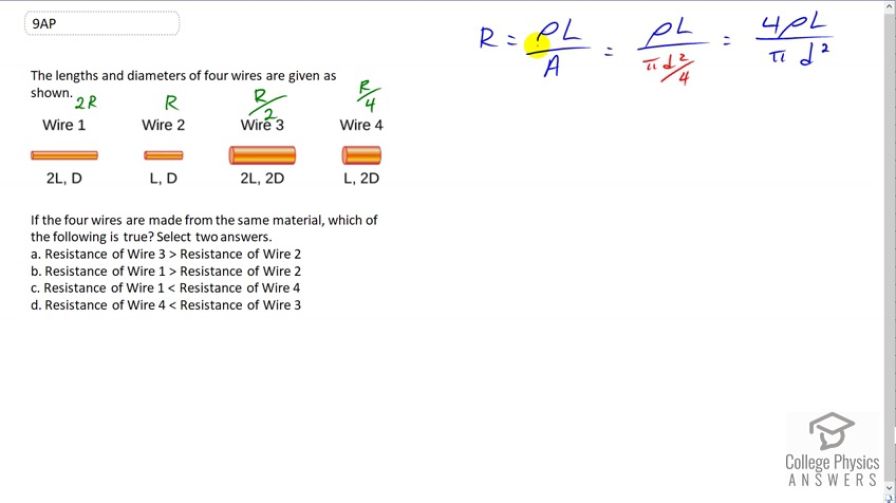Question
The lengths and diameters of four wires are given as shown. If the four wires are made from the same material, which of the following is true? Select two answers.

Final Answer
(b) and (d)
Solution video
OpenStax College Physics for AP® Courses, Chapter 20, Problem 9 (Test Prep for AP® Courses)

vote with a rating of
votes with an average rating of
.
Video Transcript
This is College Physics Answers with Shaun Dychko. Let's remind ourselves of the formula for resistance in terms of the length and the diameter of a wire. It is the resistivity of the material multiplied by its length, divided by its cross-sectional area. We can express cross-sectional area in terms of diameter by substituting pi diameter squared divided by four. So this makes four rho l over pi d squared. So resistance is directly proportional to length and inversely proportional to the square of the diameter. So what this means is if you double l, you double R, and if you double d, you decrease R by a factor of a quarter because the factor by which you change d is squared and it's in the denominator and so you're dividing by whatever factor gets squared. So I found it helpful to label the resistances for each of these wires and I chose to make this one resistance R. It has a length of l and a diameter of d and wire one is going to be two times R because it has twice the length. When you substitute two l in here you get two R. Then I looked at wire four and I saw that it's the same length as wire two but the diameter is doubled and so if you double the diameter you have to square that doubling and you have a factor of four in the denominator in which case this resistance gets divided by four. Then wire three is double the resistance of wire four because it has twice the length and the same diameter. So two times R over four is R over two. Now that we have all the resistances of these wires, we can go through each of these possibilities. Wire three is greater than wire two, that's not true, wire three is half of resistance of wire two. Resistance of wire one is greater than resistance of wire two, that's true because it's greater by a factor of two. So B is one of our answers. Then the other answer is D, the resistance of wire four is less than that of wire three. Yep, exactly, because it's half the length and so it's half the resistance of wire three. There, B and D are the answers.